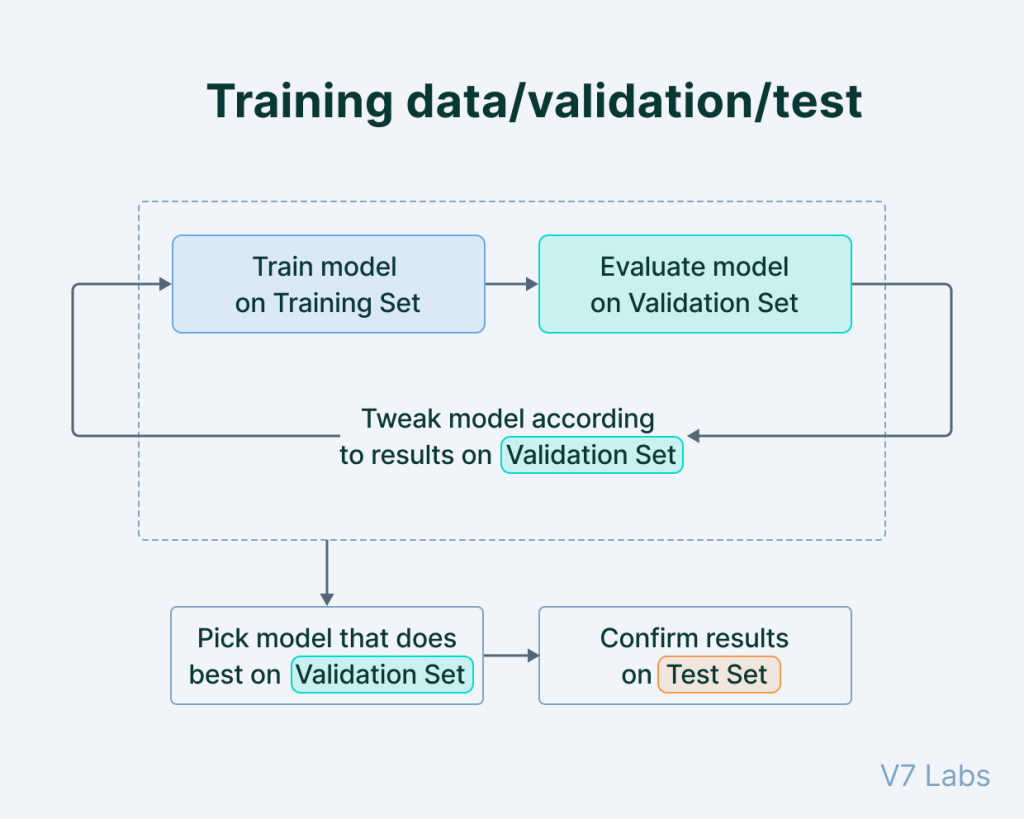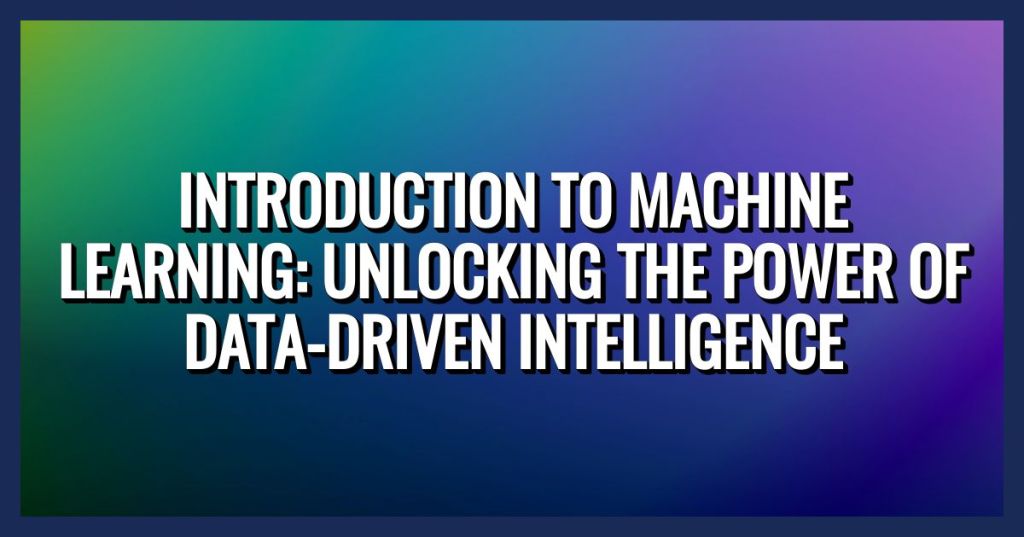Machine learning has become a hot topic on the tech side of things. Even if many don’t realize it, it’s a part of everyday life. It’s everywhere, from voice assistants like Siri to recommendation engines on Netflix.
This fascinating field of computer science is changing the world. It’s making our lives easier, more efficient, and even more fun. But what exactly is machine learning?
Particularly, machine learning is a method of data analysis. It automates analytical model building. It’s a way for computers to learn from data, identify patterns, and make decisions without human intervention.
Have you ever wondered how your email knows what’s spam and what’s not? Or how Facebook can recognize your face in a photo? That’s machine learning at work.
Why learn about Machine Learning?
This blog post will dive deep into the world of machine learning. We’ll cover the basics, explore its uses, and even touch on advanced topics. So let’s start this journey of discovery and learn about the wonders of machine learning.
Learning about machine learning as a software engineer will greatly enhance your abilities in three key areas. Firstly, it provides you with a powerful tool to significantly reduce the time spent on programming tasks. For instance, let’s say you wanted to create a program that corrects spelling errors. Instead of laboring over countless examples and rules, like “I before E except after C,” and investing weeks of effort, you could leverage an existing machine learning tool. By feeding it a few relevant examples, you can quickly obtain a more reliable program. This means achieving the same outcome in a fraction of the time.
Secondly, machine learning empowers you to customize your products to better serve specific groups of people. Imagine you successfully develop an English spelling corrector by manually writing code. If you wanted to expand its capabilities to include the 100 most popular languages, you would normally have to start almost from scratch for each language, requiring years of effort. However, with machine learning, the process becomes much simpler. Essentially, you just need to gather data in the desired language and feed it into the same machine-learning model. This enables you to efficiently adapt your products to different languages, saving significant time and resources.
Thirdly, machine learning allows you to tackle problems that may seem tedious when approached manually. As a human being, you possess the innate ability to recognize your friends’ faces and understand their speech. However, if you were asked to write a program to perform these tasks, you would likely find it perplexing. This is where machine learning algorithms excel. They can effortlessly handle these types of tasks. Rather than explicitly instructing the algorithm what to do, you simply provide it with numerous examples. The algorithm can then learn from these examples and successfully complete the given task.
By embracing machine learning, you can enhance your programming abilities, save time, customize your products, and tackle complex problems that would otherwise be challenging to address manually. So, dive into the world of machine learning and unlock a whole new realm of possibilities for your software engineering endeavors.
Definition and Explanation
Machine Learning involves training a computer system to automatically learn and recognize patterns in data, and then use this knowledge to perform specific tasks or make accurate predictions. It uses statistical techniques to enable computers to learn from experience, without being explicitly programmed for each possible scenario.
By analyzing large amounts of data, Machine Learning algorithms can identify trends, patterns, and relationships that humans may not easily discover. This ability to extract valuable insights from data makes Machine Learning a powerful tool in various fields, including finance, healthcare, marketing, and more.
Importance of Machine Learning in Today’s World
Machine Learning plays a crucial role in today’s world, where vast amounts of data are generated every second. Here are some key reasons why Machine Learning is important:
- Data-driven Decision Making: Machine Learning enables businesses and organizations to make informed decisions by analyzing and interpreting large datasets.
- Automation and Efficiency: By automating repetitive tasks, Machine Learning reduces human effort and improves efficiency.
- Personalization: Machine Learning algorithms can analyze user behavior and preferences to provide personalized recommendations and experiences.
- Fraud Detection: Machine Learning models can identify patterns and anomalies in data, helping detect fraudulent activities and enhancing security.
- Medical Diagnosis: Machine Learning algorithms can assist in diagnosing diseases and predicting patient outcomes based on medical data analysis.
Machine Learning is revolutionizing various industries, driving innovation, and transforming the way businesses operate in the digital age.
Data Collection and Preparation
Before machine learning can take place, relevant data needs to be collected and prepared. This involves gathering a large dataset that represents the problem at hand. The data should be cleaned, organized, and transformed into a format that can be easily understood by machine learning algorithms.

Training and Testing Models
Once the data is ready, machine learning models are trained using various algorithms. These algorithms analyze the data to identify patterns and correlations, allowing the models to make predictions or decisions based on new inputs. The models are trained using a subset of the data called the training set or testing set.

Evaluation and Improvement
After training the models, they need to be evaluated to determine their performance. This is done using a separate dataset called the testing set. The models are tested on this dataset to measure their accuracy and effectiveness.
If the models perform well, they can be deployed for real-world applications. However, if the performance is not satisfactory, the models need to be refined and improved. This may involve adjusting the algorithms, collecting more data, or fine-tuning the model parameters.
In conclusion, machine learning works through the process of data collection and preparation, training and testing models, and evaluation and improvement. This iterative approach allows machines to learn from experience and make predictions or decisions based on patterns in the data.
Types of Machine Learning
Machine learning is a sub-field of artificial intelligence that involves the development of algorithms and statistical models that enable computers to improve their performance in tasks through experience. There are several types of machine learning, each serving a unique purpose. Let’s explore three of the main types: supervised learning, unsupervised learning, and reinforcement learning.
Supervised Learning
Supervised learning is a type of machine learning where the model is trained on labeled data. Labeled data means that the input data has already been tagged with the correct output. The goal of supervised learning is to teach the model to make accurate predictions or classifications based on new, unseen data.
For example, imagine you have a dataset of images of fruits, each labeled with the corresponding fruit name. By training a supervised learning model on this data, you can teach the model to recognize and classify fruits in new images.
Supervised learning algorithms include decision trees, support vector machines, and neural networks. These algorithms learn from the provided examples and then generalize the learned patterns to make predictions on new, unseen data.
Unsupervised Learning
In contrast to supervised learning, unsupervised learning involves training a model on unlabeled data. Unlabeled data means that the input data does not come with any predefined output or class labels. The goal of unsupervised learning is to discover patterns, relationships, or structures within the data.
For instance, imagine you have a dataset of customer purchase history without any information about specific customer segments. By applying unsupervised learning techniques, you can cluster similar customers together based on their purchase behavior, revealing hidden customer segments.
Unsupervised learning algorithms include clustering algorithms like k-means clustering and hierarchical clustering, as well as dimensionality reduction techniques such as principal component analysis (PCA).
Reinforcement Learning
Reinforcement learning is a type of machine learning where the machine learns to make decisions through trial-and-error interactions with its environment. The machine receives feedback in the form of rewards or punishments based on its actions, and its goal is to maximize the cumulative rewards over time.
Think of a game-playing AI that learns to play a game by playing it multiple times and receiving positive rewards for winning and negative rewards for losing. Through this iterative process, the AI gradually improves its strategy and becomes more successful at the game.
Reinforcement learning algorithms include Q-learning and deep reinforcement learning, which leverage neural networks to handle complex decision-making tasks.
Machine learning is a powerful tool with diverse applications, including image and speech recognition, natural language processing, and recommender systems. Understanding the different types of machine learning can help us choose the most suitable approach for a given problem.
Semi-Supervised Learning
I didn’t include this learning in the introduction but, semi-supervised learning is a powerful technique that deserves our attention. This method, which combines elements of both supervised and unsupervised learning, allows us to make the most of the data available to us. In supervised learning, we rely on labeled data to train our models. However, obtaining labeled data can be time-consuming and expensive. On the other hand, unsupervised learning does not require labeled data, but it often lacks the precision and accuracy that we desire.
Enter semi-supervised learning, the perfect blend of the two. With this approach, we can leverage a small amount of labeled data and a larger amount of unlabeled data to train our models. By using the unlabeled data, we can tap into a vast amount of information that would otherwise go untapped. This allows us to make more informed predictions and gain a deeper understanding of the underlying patterns in our data.
Imagine the possibilities that semi-supervised learning opens up for us. We can tackle complex problems with limited labeled data, saving time and resources. We can expand our knowledge and insights by utilizing the vast amounts of unlabeled data that is readily available in various domains. By embracing semi-supervised learning, we are taking a step towards more efficient and effective machine learning models.
So, next time you come across a problem where labeled data is scarce, consider the power of semi-supervised learning. It may just be the key to unlocking new possibilities and achieving greater success in your data-driven endeavors.
We learned about the most common types of machine learning, semi-supervised being used the least and not because it’s not useful. To learn more about machine learning check out DataCamp! They are constantly adding new classes about ChatGPT prompts, AI, data science, and machine learning! (This author is sponsored by DataCamp)
Real-World Applications of Machine Learning
Machine learning, a rapidly growing technology, has found its way into various aspects of our lives. From healthcare to finance, e-commerce to self-driving cars, the applications of machine learning are vast and impactful. In this section, we will explore some of the most trending real-world applications of machine learning.
Healthcare and Medicine

Machine learning has revolutionized the healthcare and medicine industry. It has the potential to improve patient care, disease diagnosis, and treatment outcomes. By analyzing vast amounts of medical data, machine learning algorithms can identify patterns, predict patient outcomes, and assist in early disease detection. For example, machine learning models can analyze medical images such as X-rays, MRIs, and CT scans to detect abnormalities or assist in diagnosing diseases like cancer.
One notable application is the use of machine learning in personalized medicine. By analyzing a patient’s genetic information, medical history, and lifestyle factors, machine-learning algorithms can recommend tailored treatments and predict the effectiveness of certain medications or therapies.
If this topic interests you and you would like to learn more about AI in healthcare check out my article about Narrow AI’s impact in medicine and healthcare.
Finance and Banking
Machine learning has become an integral part of the finance and banking industry. It helps in risk assessment, fraud detection, and improving customer experience. By analyzing historical financial data and market trends, machine learning algorithms can predict market movements, optimize investment strategies, and identify potential risks.

Another application is fraud detection. Machine learning algorithms can analyze large volumes of financial transactions in real-time, identifying suspicious patterns and detecting fraudulent activities. This helps in minimizing financial losses and protecting customer assets.
E-commerce and Retail

Machine learning has transformed the way we shop online. E-commerce giants like Amazon and Netflix use machine learning algorithms to provide personalized recommendations to users. By analyzing user behavior, purchase history, and product attributes, these algorithms can suggest products or content that match the user’s preferences and interests.
Furthermore, machine learning enables e-commerce companies to optimize their supply chain management, inventory forecasting, and pricing strategies. By analyzing vast amounts of data, machine learning algorithms can predict demand patterns, optimize stock levels, and adjust prices dynamically to meet customer demands.
In conclusion, machine learning has found numerous applications in various industries, impacting our lives in significant ways. From healthcare to finance, e-commerce to self-driving cars, the potential of machine learning is vast and promising.
Advantages and Challenges of Machine Learning
Machine Learning (ML) is a powerful tool with the potential to revolutionize various industries. It offers numerous advantages, but also comes with its fair share of challenges and limitations. Let’s explore both sides of the coin.
Advantages of Machine Learning
Machine Learning brings several advantages to the table:
- Easily identifies trends and patterns: ML can analyze vast amounts of data, uncovering trends and patterns that may not be apparent to humans. For example, e-commerce giant Amazon utilizes ML to understand user browsing behavior and purchase history, enabling them to offer personalized product recommendations and targeted advertisements.
- No human intervention needed (automation): With ML, projects can run autonomously. Machines can learn and make predictions, continuously improving algorithms on their own. Anti-virus software is a prime example, as it learns to detect and filter new threats. ML is also effective in recognizing spam.
 A Woman Holding a Digital Tablet (Photo by Michelangelo Buonarroti)
A Woman Holding a Digital Tablet (Photo by Michelangelo Buonarroti) - Continuous improvement: ML algorithms enhance their accuracy and efficiency over time through experience. As more data becomes available, algorithms learn to make more precise predictions at a faster pace. This benefit is particularly valuable in fields like weather forecasting.
- Handling multi-dimensional and multi-variety data: ML algorithms process complex, multi-dimensional data in uncertain environments. This capability makes them suitable for various industries, including e-commerce and healthcare, enabling more personalized customer experiences.
- Wide applications: Whether you’re an e-tailer or a healthcare provider, ML can be customized to meet your specific needs. It has the potential to optimize processes, improve decision-making, and enhance customer targeting.
Challenges and Limitations of Machine Learning
While ML offers remarkable advantages, it also faces certain challenges:
- Data acquisition: ML requires massive, inclusive, and high-quality datasets for training. Obtaining such datasets can be time-consuming and resource-intensive. Additionally, waiting for new data to be generated can cause delays in the learning process.
- Time and resources: ML algorithms require sufficient time to learn and develop accuracy. They also demand significant computational resources, potentially necessitating additional computer power.
- Interpretation of results: Accurately interpreting the results generated by ML algorithms can be complex. Selecting the appropriate algorithms for specific purposes is crucial to ensure accurate and meaningful insights.
- High error-susceptibility: ML is autonomous but prone to errors. If training datasets are biased or incomplete, algorithms may produce biased predictions. This can lead to irrelevant advertisements or flawed decision-making. Detecting and rectifying such errors can be challenging.
Despite these challenges, the potential benefits and applications of Machine Learning continue to expand, paving the way for a future where intelligent machines can greatly assist and transform various industries.
Future Trends in Machine Learning
Machine learning is an ever-evolving field that continues to shape the way we interact with technology. In this section, we will explore some of the exciting future trends in machine learning that are set to revolutionize various industries.
Deep Learning and Neural Networks

Deep learning and neural networks are at the forefront of machine learning advancements. These techniques aim to mimic the human brain’s structure and functioning, enabling machines to learn and make decisions independently. With their ability to process vast amounts of complex data, deep learning and neural networks are transforming industries such as healthcare, finance, and autonomous vehicles.
To delve deeper into the world of deep learning and neural networks, check out this comprehensive guide.
Explainable AI
Explainable AI focuses on developing machine learning models that provide transparent explanations for their decisions. It aims to address the “black box” problem, where traditional machine learning models lack interpretability. By understanding the reasoning behind AI-driven decisions, businesses, and individuals can trust and utilize these technologies more effectively.
Algorithms can sometimes show biases based on race because they haven’t learned enough from the information they have been given. This is similar to people in small communities who don’t know much about the world and may be cautious of outsiders. Machines can develop these limitations if they only receive the same information and don’t see different perspectives.
Recently, fifteen experts from Germany and Switzerland, who have backgrounds in medicine and neuroscience, were interviewed about using machine learning in psychiatry. They discussed how explainability in machine learning is similar to how doctors and psychiatrists work with their patients. It involves drawing conclusions and filling in missing information. These experts had different opinions about the importance of explainability in machine learning systems. Some saw it as a way to hide problems with data and model transparency. The study also emphasized the need for a balanced relationship between patients, doctors, and machine learning systems, so that the use of AI doesn’t harm patient care or autonomy.
As we embrace the benefits of machine learning, it’s important to consider the ethical implications. We need to make sure that the data we use doesn’t favor one group of people over another, that we are transparent about how we use and process data, and that we are responsible in our use of data while respecting people’s privacy.
In conclusion, while AI and machine learning have great potential, we need to be careful about the ethical issues they raise. As we continue to explore and use these technologies, we must strive for fairness, transparency, and respect for privacy.
For more insights into explainable AI, refer to this Amazon Article – Interpretability vs Explainability
Ethical Considerations

As machine learning becomes increasingly integrated into our lives, ethical considerations are paramount. It is essential to weigh the potential benefits against potential harms and ensure fair and unbiased decision-making. Understanding the ethical implications of machine learning is crucial for creating responsible and trustworthy AI systems.
Learn more about the ethical dimensions of machine learning from this KDNuggets article.
Getting Started with Machine Learning
Machine learning is a fascinating field that has gained immense popularity in recent years. Whether you’re an aspiring data scientist or a curious individual looking to explore this exciting domain, this section will provide you with the essential resources and tools to get started on your machine learning journey.
Learning Resources and Courses

When it comes to learning machine learning, there is a wealth of resources available to help you grasp the concepts and techniques. Some highly recommended books include “Hands-On Machine Learning with Scikit-Learn and TensorFlow” by Aurélien Géron and “Pattern Recognition and Machine Learning” by Christopher Bishop. These books provide comprehensive coverage of the subject and serve as excellent references throughout your learning journey.
For those who prefer online courses, platforms like Coursera, Udemy, and edX offer a wide range of machine learning courses. The “Machine Learning” course by Andrew Ng on Coursera is highly acclaimed and provides a solid foundation in the field. Additionally, Kaggle, a platform for data science competitions, offers interactive tutorials and challenges that can help you enhance your practical skills.
These are just sources I know to be highly acclaimed, another source that I am currently dipping my toes into that will teach machine learning for anyone interested in making it a career is: Google Developer – Intro to Machine Learning
Tools and Programming Languages

When it comes to implementing machine learning algorithms, you’ll need to familiarize yourself with various tools and programming languages. Here are three popular options:
By familiarizing yourself with these tools and programming languages, you’ll be equipped to implement machine-learning algorithms and explore the exciting possibilities that this field offers.
- Python: Python is widely regarded as the go-to language for machine learning. Its simplicity, vast library ecosystem (including sci-kit-learn and TensorFlow), and active community make it an excellent choice for beginners. You can refer to the official Python documentation and online tutorials to get started.
- R: R is another powerful language that is widely used in the field of data science and machine learning. It offers a rich set of libraries, such as caret and randomForest, that simplify the implementation of machine learning algorithms. The RStudio website provides comprehensive documentation and tutorials to help you get started with R.
- Weka: Weka is a well-known set of software and tools for machine learning and data mining. It was created at the University of Waikato in New Zealand and is widely used by researchers, data scientists, and professionals in different fields. Weka offers a wide range of algorithms that can be used for tasks like classification, regression, clustering, association rules, and feature selection. These algorithms help analyze and model data, making predictions and uncovering patterns and relationships in datasets.
One of the main advantages of Weka is its easy-to-use graphical interface. Users can interactively explore and manipulate data and configure and run machine learning experiments. The interface presents data visually, allowing users to preprocess, transform, and visualize data before using machine learning algorithms. In addition to the graphical interface, Weka provides a Java-based API that will enable developers to incorporate Weka’s functionality into their own applications or workflows.
Advanced users can create customized data analysis pipelines or build automated systems using Weka’s algorithms and techniques. Weka supports various data formats and offers multiple evaluation metrics to assess the performance of machine learning models. It also includes tools for data preprocessing, such as filtering, selecting attributes, and normalizing data, which can enhance the quality and suitability of the input data. Overall, Weka is a versatile and powerful tool for machine learning and data mining. Its user-friendly interface, extensive collection of algorithms, and flexibility make it a popular choice for both beginners and experienced professionals in the field of data analysis.
Conclusion
In conclusion, machine learning is a powerful tool that has revolutionized various industries. It allows computers to learn from data and make accurate predictions or decisions without being explicitly programmed. By leveraging algorithms and statistical models, machine learning has enabled advancements in fields such as healthcare, finance, and technology. With its ability to process vast amounts of data and identify patterns, machine learning has the potential to drive innovation and improve efficiency across many sectors.
Additionally, machine learning algorithms have the capacity to continuously learn and improve over time, making them invaluable in solving complex problems. From image recognition to natural language processing, machine learning has proven to be highly effective in tackling tasks that were previously considered challenging for computers.
As businesses increasingly adopt machine learning techniques, it is crucial to have a solid understanding of its principles and applications. By staying up-to-date with the latest advancements in machine learning, individuals can position themselves for success in this rapidly evolving field.
In conclusion, machine learning is an exciting and promising technology that is reshaping the way we live and work. Embracing this technology and its potential can lead to groundbreaking discoveries, increased efficiency, and improved decision-making. So, let’s continue to explore the fascinating world of machine learning and unlock its full potential for a better future.
So, what aspect of AI and ML intrigues you the most? We’d love to hear your thoughts in the comments below. Feel free to also leave any feedback you have for me that you like or don’t like about my blog. And if you’re eager for more insights into AI and ML, don’t forget to subscribe to our newsletter to stay updated with future content just like this!
Resources:
- Biba, J. (2022, September 29). Types of Machine Learning: Supervised, Unsupervised & More. Built In. Retrieved from https://builtin.com/machine-learning/types-of-machine-learning
- Tableau. (n.d.). 10 Machine Learning Examples in Everyday Life. Retrieved from https://www.tableau.com/learn/articles/machine-learning-examples
- Miceli, M., Yang, T., Alvarado Garcia, A., Posada, J., Wang, S. M., Pohl, M., & Hanna, A. (2022). Documenting Data Production Processes: A Participatory Approach for Data Work. Proceedings of the ACM on Human-Computer Interaction, 6(CSCW2). Retrieved from https://doi.org/10.48550/arXiv.2207.04958
- “Ethical challenges of machine learning in psychiatry—A qualitative study” by G. Schicktanz, B. Schicktanz, and E. D. C. Jongsma, published in AI and Ethics in 2023. https://link.springer.com/content/pdf/10.1007/s43681-022-00177-1.pdf
- UK Statistics Authority. (2021, October 26). Ethical considerations in the use of machine learning for research and statistics. Retrieved from https://uksa.statisticsauthority.gov.uk/publication/ethical-considerations-in-the-use-of-machine-learning-for-research-and-statistics/pages/1/
- Kumar, Y., Koul, A., Singla, R., & Ijaz, M. F. (2023). Artificial intelligence in disease diagnosis: a systematic literature review, synthesizing framework and future research agenda. Journal of Ambient Intelligence and Humanized Computing, 14(7), 8459-8486. https://doi.org/10.1007/s12652-021-03612-z



Leave a comment